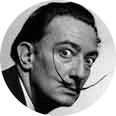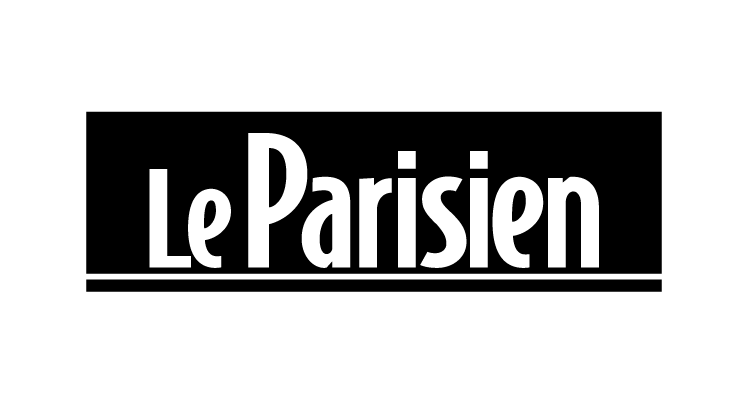Artwork of Salvador Dali artprints & posters
Salvador Dali, undisputed master of surrealism, captivated the world with his artistic genius and boundless imagination. Known for his audacity and originality, his paintings depict dreamlike visions that defy reality, arousing both curiosity and fascination. Dali was not only a painter, but also a symbol of extravagance and eccentricity, leaving an indelible mark on the history of art. Discover Salvador Dali's finest paintings, including “The Persistence of Memory”, the artist's most famous surrealist work, “Portrait of Gala with Rhinocerotic Symptoms”, depicting his wife and muse Gala in the setting of Cadaques, his two main sources of inspiration, and “Christ of Saint John of the Cross”, a testimony to his return to the Catholic faith.
Gift yourself a reproduction of one of Salvador Dali's works, and discover the life of history's most famous surrealist artist by browsing his biography.
Biography of Salvador Dali
The childhood of Salvador Dali
Born in 1904 in the small Catalan town of Figueras (or Figueres), with the port of Cadaques as a backdrop, which would inspire the future Surrealist painter in his various works, Salvador Dali was born into a family, with a notary father, and a mother who would provide the gentleness essential to the young artist's blossoming, in contradistinction to his father's more authoritarian character. Throughout the first part of his life, Salvador Dali was surrounded by his sister, born when he was four, who would later write a book about her brother. He was also born 9 months after the death of his brother, whom he mentions sharing his feeling of being his brother's reincarnation.
In Cadaquès, at the age of 12, Dali attended an exhibition by Ramon Pichot, a local Spanish Impressionist painter. Young Salvador's father encouraged him to take painting lessons, and enrolled him in the municipal engraving school. Recognizing his talent, Dali's father exhibited his son's first works in the family home, before the latter took part in his first group exhibition in 1919 at the municipal theater in Figueras, followed by a second in Barcelona.
Aside from art, at the age of 15, Salvador Dali moved closer to Marxist and socialist ideals, and took part in several political groups and magazines, in which he integrated art with articles on renowned painters such as Goya or Da Vinci. In 1921, his mother died, leaving the young man devastated, and in 1922, Dali left the family home for Madrid to attend the Royal Academy of Fine Arts in San Fernando.
Salvador Dali's artistic beginnings
Arrived in Madrid, having left Figueres and the port of Cadaques to initiate his life as an artist, Salvador Dali began to sport an eccentric dandy style that quickly attracted the attention of fellow students and teachers alike. With his painting, too, the painter stood out in the midst of the Spanish school, Dali drawing inspiration from the cubist images to which Pichot had introduced him the year before his departure. However, while Picasso was a worthy representative of Spanish cubism, in Madrid this style of painting was not in vogue, and Dali made do with slim sources of inspiration from a few articles in the specialized press.
Aside from his training, Dali met other thinkers and artists, such as Luis Buñuel, with whom he would discover Freudian thought, the poets Pedro Garfias and Federico García Lorca, and the writer Pepín Bello. Accompanied by this group, Dali began to draw inspiration from Surrealism, then discovered Dadaism in 1924, a movement that would have a major impact on his work.
In 1925, Dali returned to Catalonia, and more specifically to Cadaques and then Barcelona, to paint and present his first solo exhibition, featuring, among other works, the painting “Portrait de mon père”, an oil on canvas considered one of the most successful of his early years.
Salvador Dali's Parisian years
After completing his academic studies in Madrid, Salvador Dali made his first trip to Paris in 1927. While there, he first met Picasso, the artist who was a reference point for Dali at the time, and with whom he would remain in contact throughout his life. In Paris, Dali continued to study classical painting, but mixed techniques, drawing inspiration from encounters with Magritte, Paul Éluard and André Breton, all of whom had a significant impact on his work.
Also close to the Surrealist group, it was during this period that he became close to Elena Ivanovna Diakonova, Paul Éluard's wife, more commonly known as Gala. Gala began by organizing exhibitions and selling Dali's work, before embarking on an affair with him, despite the 10-year age difference between them, and becoming the Spanish painter's muse. The couple bought their first house in Portlligat, unable to settle in Cadaques as Dali had fallen out with his family because he was seeing a married woman. The modest house in Portlligat thus became one of the painter's main inspirations, and later became a museum dedicated to Dali. The Catalan painter and Gala eventually married in 1934, regularizing their situation and making Gala a source of continuing inspiration for Dali.
Salvador Dali and the Surrealists
When Dali arrived in Paris, the city was a veritable melting pot of painters, writers and thinkers in search of new forms of artistic expression. It was against this backdrop that Surrealism emerged, led by André Breton. Breton, who had already drawn up the Surrealist manifesto, wanted to share his vision of an art that transcended reality.
Salvador Dali, with his fascination for the subconscious and his ability to transpose dreams and hallucinations onto canvas, quickly established himself as a leading figure among the Surrealists. With paintings such as “Le Sommeil” and his “La persistance de la mémoire”, Dali won widespread acclaim for his bold use of paint to represent dreamlike visions. André Breton quickly recognized Dali's talent and welcomed him into the Surrealist group, with the painter even taking part in the 6th “Salon des surindépendants”. The relationship between Breton and Dali was both complex and fruitful. Despite their differences and occasional conflicts, Breton's influence on Dali was undeniable, having introduced him to the fundamental principles of Surrealism, as Picasso had done some time earlier with Cubism.
In return, from the late 1920s onwards, Dali brought a new dimension to Surrealism. Thanks to his unique style and innovative ideas, and being set up as the movement's figurehead, much to the dismay of Breton who had theorized it, he succeeded in paving the way for a new generation of artists. His contribution as a Surrealist not only established his status as a leading Spanish painter, but also solidified the importance of Paris as the center of global Surrealism.
The American years and international recognition for Salvador Dali
Salvador Dali's first contact with the United States came in 1934, following an exhibition of his work organized by Julien Levy in New York a year earlier. Accompanied by his muse and wife, Gala, Dali discovered this cosmopolitan city with wonder. This first American experience was to prove decisive for the artist, both personally and professionally. The “Big Apple” quickly became an inexhaustible source of inspiration for Dali, who immersed himself in the city's effervescence and boundless energy.
In 1939, in the midst of World War II and with Spain torn apart by civil war, Dali and Gala decided to leave their home in Portlligat and move to New York. During these eight years of exile, the Catalan painter immersed himself totally in American culture, which had a considerable influence on his paintings. Dali drew inspiration from the American way of life, its urban landscapes and cultural symbols to create bold, avant-garde canvases, such as his work “Poetry of America - Cosmic Athletes”, which incorporates elements of American popular culture.
It was also during this period that Dali collaborated with Walt Disney. Together they created the short film “Destino”, which was not completed and released until 2003, long after their deaths. This unexpected collaboration between these two emblematic figures of their time marked a new stage in Dali's career, as he experimented with other art forms.
Salvador Dali returns to Spain: The consecration
In 1949, after 8 years in the United States, Salvador Dali and Gala decided to return to Europe. It was in Spain, in the familiar setting of Catalonia, that the couple chose to settle. This return to his native land marked a significant transition in Dali's life and work. He was profoundly marked by a renewal of his Catholic faith, which he had set aside in his younger years. This spiritual return was reflected in his works, with increasingly mystical and religious themes.
Dali didn't just paint conventional religious themes, he brought his own interpretation to them, as in his “Christ of St. John of the Cross”, a surrealist interpretation of the crucifixion of Jesus, where Christ is depicted in plunging perspective, suspended above a coastal landscape, showing the extent to which Dali was able to fuse his renewed faith with surrealism. Equally fascinated by the scientific discoveries of the time, the Spanish painter began to incorporate elements of quantum physics and genetics into his work, as in his “Corpus Hypercubus”, where Dali depicts the crucifixion of Jesus on a hypercube, a four-dimensional geometric figure. In his constant quest for innovation, Dali also experimented with other artistic techniques. He would use pointillism, holography and trompe-l'œil to create visual illusions, all of which would later have a major impact on the development of pop art.
In 1959, Dali took part in the “Hommage au surréalisme” exhibition, alongside André Breton, Max Ernst and Joan Miró. This confirmed Dali's place as one of the greatest Surrealist painters of his time. In 1970, Dali and Gala moved into the Château de Púbol, and in 1974, Dali fulfilled a long-held dream by inaugurating the Dali Theatre-Museum in Figueras. This museum designed by Dali himself, with its geodesic dome and facade adorned with giant eggs, houses a large collection of his works, ranging from his earliest artistic experiments to his most recent creations.
The end of Salvador Dali's life was marked by illness and solitude. Gala died in 1982, leaving Dali devastated. He retired to the Château de Púbol, and in 1989 died of heart failure at the age of 84. He is buried in his Theatre-Museum in Figueras, where his spirit lives on through his art.
Salvador Dali's legacy and posterity
After his death, as the undisputed master of the Surrealist movement, Salvador Dali left an indelible artistic legacy that continues to fascinate and inspire generations of artists. His bold, avant-garde works marked an era and defined a unique artistic period. Now exhibited in the world's most prestigious museums, from MoMA in New York to the Centre Pompidou in Paris and the Tate Modern in London, the recognition of his work underlines its global impact. The Dali Theatre-Museum in Figueres, however, remains the true sanctuary of his creative genius, where many of his paintings can be seen, bringing his legacy to life.
The Salvador Dali myth
Becoming a cultural icon, a mythical figure who captivated the public's attention far beyond his works, Salvador Dali's uniqueness, bold images and eccentric portraiture created an aura that made him a fixture of popular culture. Whether in film, advertising or music, the imprint left by this extraordinary artist is indelible.
Dali wasn't just an artist, he was a living work of art. His images, often surreal and disconcerting, defied convention and broke new ground in the art world. His works, though rooted in surrealism, transcended genres and influenced many fields, from fashion to photography.
His style, marked by an extravagant moustache and theatrical demeanor, made him an unforgettable figure, his spiraling moustache even becoming an iconic image of the painter as a character in his own right.
Salvador Dali's psychoanalytical influences
Following the principles of Surrealist art, Salvador Dali created a unique body of work imbued with strange and fascinating imagery. His most prolific period was marked by a strong influence from Freud's psychoanalysis. Dali was fascinated by the psychoanalyst's theories on the subconscious, dream interpretation and the importance of repressed desires. These concepts profoundly influenced his work, giving rise to canvases that defied logic and explored the depths of the human mind.
From then on, Dali's works became a visual exploration of Freud's theories, transforming abstract ideas into concrete images, fusing art and psychoanalysis in unprecedented ways, creating an artistic universe that continues to fascinate and inspire to this day.
Salvador Dali's innovation in the visual arts
In addition to being a renowned painter, Salvador Dali also became synonymous with innovation in the visual arts. His work transcends the boundaries of traditional art, exploring bold, avant-garde forms of expression. A truly versatile artist, Dali explored cinema, sculpture, photography and even jewelry design. Each period of his artistic life was marked by a new exploration, a new way of pushing back the boundaries of art, thanks to a boundless imagination.
Today, Dali's imprint remains indelible on the visual arts world, his work continuing to inspire and provoke in many different mediums, the painter having proved that art has no boundaries.
Learn more about the life and the works of Salvador Dali.




























